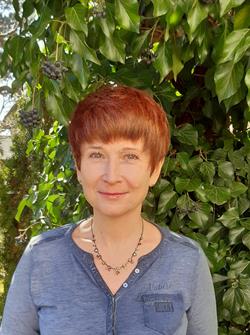Introducing doc. Kateřina Jirsová and her research team
 Doc. Kateřina
Jirsová’s team at the Laboratory of Biology and Pathology of the Eye (LBPE) of
the Department of Biology and Medical Genetics of the First Faculty of Medicine
of the Charles University and General University Hospital includes doc. Jan Bednár, MUDr. Viera Veselá, PhD students Mgr.
Ingrida Šmeringaiová, João Victor Cabral, MD, and further doctoral students of
the General University Hospital and University Hospital Motol.
Doc. Kateřina
Jirsová’s team at the Laboratory of Biology and Pathology of the Eye (LBPE) of
the Department of Biology and Medical Genetics of the First Faculty of Medicine
of the Charles University and General University Hospital includes doc. Jan Bednár, MUDr. Viera Veselá, PhD students Mgr.
Ingrida Šmeringaiová, João Victor Cabral, MD, and further doctoral students of
the General University Hospital and University Hospital Motol.
Focus
The team is engaged in basic and
applied research in the biology and pathology of the eye and issues related to
transplantation. Its research aims at characterising healthy and pathological
eye surface, investigation of pathogenesis of the dry eye syndrome and limbal
stem cell deficiency. The team is also active in the development of new types
of tissues and cells that have the potential of being introduced into
preclinical and clinical transplant practice (limbal stem cells, amniotic
membrane, endothelium of the cornea). Its aim is to propose innovations in
graft preparation and storage, and to improve the quality and extend the
survival of graft material. The LBPE team also offers laboratory diagnostics of
the dry eye syndrome and limbal stem cell deficiency.
Collaborations, projects
In collaboration with tissue banks of the University Hospital Motol and University Hospital Královské Vinohrady, the LBPE team participates in the preparation of grafts for transplants and works closely with the Bank of Biological Material of the First Faculty of Medicine of the Charles University. In 2020, Kateřina Jirsová, the team leader, is the main researcher or co-researcher of the following projects:
* Application of amniotic membrane in the treatment of long-term non-healing wounds, NV18-08-00106. The aim of this project is to standardise the treatment of chronic wounds using the amniotic membrane (in collaboration with University Hospitals Motol and Královské Vinohrady as well as Na Homolce Hospital), to find new substances that could promote healing and deliver an analgesic effect, and by modification of preparation and storage conditions minimise the decrease of activity of effective agents in the amniotic membrane.
* PROGRES Q25 – is a university project in which the LBPE participates.
* Analysis of Czech genomes for theranostics, EF16_026/0008448 (BBM). This project should result in the creation of control database of genetic information typical of Czech population, which should contribute to precise diagnostics of genetic diseases. At this point, samples of individuals from all regions of the Czech Republic are being collected. For further information about the project, including opportunity to get involved, see www.acgt.cz.
* BMRI-CZ: Biobank network – A universal platform to aid research in etiopathogenesis of diseases, EF16_013/0001674. Project contributing to explanation of pathogenesis and improvement of diagnostics especially of diseases involving tumours.
Internationally, the LBPE team collaborates especially with Universitetet i Oslo, Norway (Professors T. P. Utheim and A. Collins); Università Campus Bio-Medico, Rome, Italy (Dr. A. Micera, Professor S. Bonini); NILU Kjeller, Norway (Professor M. Dušinská); CNRS, France (Dr. S. Dimitrov, Dr. C. Petosa, Dr. A. Hamiche), and ENS, France (Dr. D. Angelov).
Important results
The LBPE team managed to improve the precision of diagnostics of limbal stem cell deficiency and define the condition of their cultivation (PMID: 21693612, 29928900, 29134474), include lysyl oxidase in the pathogenesis of keratoconus (PMID: 26218558, 23041260), and contribute to an explanation of pathogenesis of posterior polymorphous dystrophy (expression of pathological proteins, causes of relapse; PMID: 28414732, 19162009, 17289024, 21695473). On the level of the Czech republic, the team had contributed to the introduction of cultivated cornea (PMID: 19604163) and corneal endothelium lamellae to be used in transplantation (in collaboration with University Hospital Královské Vinohrady, doc. P. Studený; PMID: 19850580, 21963859), and to the introduction of treatment of patients with the dry eye syndrome using an autologous serum (PMID: 24074049).
For further information, contact katerina.jirsova@lf1.cuni.cz
